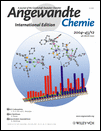Thermal and Photochemical Properties of 4′,7-Dihydroxyflavylium in Water–Ionic Liquid Biphasic Systems: A Write–Read–Erase Molecular Switch†
Fernando Pina Prof.
REQUIMTE/CQFB, Departamento de Química, Faculdade de Ciências e Tecnologia, Universidade Nova de Lisboa, 2829-516 Monte de Caparica, Portugal, Fax: (+351) 21-294-8550
Search for more papers by this authorJoão C. Lima Dr.
REQUIMTE/CQFB, Departamento de Química, Faculdade de Ciências e Tecnologia, Universidade Nova de Lisboa, 2829-516 Monte de Caparica, Portugal, Fax: (+351) 21-294-8550
Search for more papers by this authorA. Jorge Parola Dr.
REQUIMTE/CQFB, Departamento de Química, Faculdade de Ciências e Tecnologia, Universidade Nova de Lisboa, 2829-516 Monte de Caparica, Portugal, Fax: (+351) 21-294-8550
Search for more papers by this authorCarlos A. M. Afonso Dr.
REQUIMTE/CQFB, Departamento de Química, Faculdade de Ciências e Tecnologia, Universidade Nova de Lisboa, 2829-516 Monte de Caparica, Portugal, Fax: (+351) 21-294-8550
Search for more papers by this authorFernando Pina Prof.
REQUIMTE/CQFB, Departamento de Química, Faculdade de Ciências e Tecnologia, Universidade Nova de Lisboa, 2829-516 Monte de Caparica, Portugal, Fax: (+351) 21-294-8550
Search for more papers by this authorJoão C. Lima Dr.
REQUIMTE/CQFB, Departamento de Química, Faculdade de Ciências e Tecnologia, Universidade Nova de Lisboa, 2829-516 Monte de Caparica, Portugal, Fax: (+351) 21-294-8550
Search for more papers by this authorA. Jorge Parola Dr.
REQUIMTE/CQFB, Departamento de Química, Faculdade de Ciências e Tecnologia, Universidade Nova de Lisboa, 2829-516 Monte de Caparica, Portugal, Fax: (+351) 21-294-8550
Search for more papers by this authorCarlos A. M. Afonso Dr.
REQUIMTE/CQFB, Departamento de Química, Faculdade de Ciências e Tecnologia, Universidade Nova de Lisboa, 2829-516 Monte de Caparica, Portugal, Fax: (+351) 21-294-8550
Search for more papers by this authorWe thank the Fundação para a Ciência e Tecnologia and FEDER for projects POCTI/QUI/47357/2002 and POCTI/EQU/35437/1999.
Graphical Abstract
Switching colors: 4′,7-Dihydroxyflavylium (AH+) in water–ionic liquid biphasic systems can be used as a write–read–erase system. In acid media, the chalcone (Ct) form is soluble in ionic liquids and is thermally metastable, but reacts photochemically (write) to give the yellow flavylium salt, which can be optically read without being erased. The system is prepared for a new cycle by two consecutive pH “jumps”.
Supporting Information
Supporting information for this article is available on the WWW under http://www.wiley-vch.de/contents/jc_2002/2004/z53131_s.pdf or from the author.
Please note: The publisher is not responsible for the content or functionality of any supporting information supplied by the authors. Any queries (other than missing content) should be directed to the corresponding author for the article.
References
- 1
- 1aF. Pina, M. Maestri, V. Balzani, Handbook of Photochemistry and Photobiology, Vol. 3, American Scientific Publication, Research Triangle Park, 2003, chap. 9, pp. 411– 449;
- 1bF. Pina, M. J. Melo, M. Maestri, R. Ballardini, V. Balzani, J. Am. Chem. Soc. 1997, 119, 5556–5561;
- 1cF. Pina, A. Roque, M. J. Melo, M. Maestri, L. Belladelli, V. Balzani, Chem. Eur. J. 1998, 4, 1184–1191;
10.1002/(SICI)1521-3765(19980710)4:7<1184::AID-CHEM1184>3.0.CO;2-6 CAS Web of Science® Google Scholar
- 1dF. Pina, M. J. Melo, M. Maestri, P. Passaniti, V. Balzani, J. Am. Chem. Soc. 2000, 122, 4496–4498;
- 1eA. Roque, C. Lodeiro, F. Pina, M. Maestri, S. Dumas, P. Passaniti, V. Balzani, J. Am. Chem. Soc. 2003, 125, 987–994.
- 2
- 2aS. V. Dzyuba, R. A. Bartsch, Angew. Chem. 2003, 115, 158–160;
10.1002/ange.200390038 Google ScholarAngew. Chem. Int. Ed. 2003, 42, 148–150;
- 2bK. R. Seddon, Nat. Mater. 2003, 2, 1;
- 2cJ. H. Davis Jr., P. A. Fox, Chem. Commun. 2003, 1209–1212;
- 2dH. Zhao, S. V. Malhotra, Aldrichimica Acta 2002, 35, 75–83;
- 2eJ. F. Brennecke, E. J. Maginn, AIChE J. 2001, 47, 2384–2389;
- 2fJ. Dupont, C. S. Consorti, J. Spencer, J. Braz. Chem. Soc. 2000, 11, 337–344;
- 2gP. Wasserscheid, W. Keim, Angew. Chem. 2000, 112, 3926–3945;
10.1002/1521-3757(20001103)112:21<3926::AID-ANGE3926>3.0.CO;2-U Google ScholarAngew. Chem. Int. Ed. 2000, 39, 3772–3789;10.1002/1521-3773(20001103)39:21<3772::AID-ANIE3772>3.0.CO;2-5 CAS PubMed Web of Science® Google Scholar
- 2hT. Welton, Chem. Rev. 1999, 99, 2071–2083.
- 3
- 3aJ. Dupont, R. F. de Souza, P. A. Z. Suarez, Chem. Rev. 2002, 102, 3667–3692;
- 3bR. Sheldon, Chem. Commun. 2001, 2399–2407;
- 3cC. M. Gordon, Appl. Catal. A 2001, 222, 101–117.
- 4
- 4aJ. D. Holbrey, A. E. Visser, S. K. Spear, W. M. Reichert, R. P. Swatloski, G. A. Broker, R. D. Rogers, Green. Chem. 2003, 5, 129–135;
- 4bE. D. Bates, R. D. Mayton, I. Ntai, J. H. Davis, Jr., J. Am. Chem. Soc. 2002, 124, 926–927;
- 4cL. C. Branco, J. G. Crespo, C. A. M. Afonso, Angew. Chem. 2002, 41, 2895–2897;
Angew. Chem. Int. Ed. 2002, 41, 2771–2773;
10.1002/1521-3773(20020802)41:15<2771::AID-ANIE2771>3.0.CO;2-U CAS PubMed Web of Science® Google Scholar
- 4dL. C. Branco, J. G. Crespo, C. A. M. Afonso, Chem. Eur. J. 2002, 8, 3865–3871;
10.1002/1521-3765(20020902)8:17<3865::AID-CHEM3865>3.0.CO;2-L CAS PubMed Web of Science® Google Scholar
- 4eT. Schäfer, C. M. Rodrigues, C. A. M. Afonso, J. G. Crespo, Chem. Commun. 2001, 1622–1623;
- 4fA. G. Fadeev, M. M. Meagher, Chem. Commun. 2001, 295–296.
- 5F. Pina, L. Benedito, M. J. Melo, A. J. Parola, J. C. Lima, A. L. Maçanita, An. Quim. Int. Ed. 1977, 93, 111–118.
- 6M. Maestri, R. Ballardini, F. Pina, M. J. Melo, J. Chem. Educ. 1997, 74, 1314–1316.
- 7F. Pina, M. J. Melo, R. Ballardini, L. Flamigni, M. Maestri, New J. Chem. 1997, 21, 969–976.
- 8
- 8aJ.-F. Huang, P.-Y. Chen, I.-W. Sun, S. P. Wang, Inorg. Chim. Acta 2001, 320, 7–11;
- 8bJ. Dupont, P. A. Z. Suarez, R. F. De Souza, R. A. Burrow, J.-P. Kintzinger, Chem. Eur. J. 2000, 6, 2377–2381;
10.1002/1521-3765(20000703)6:13<2377::AID-CHEM2377>3.0.CO;2-L CAS PubMed Web of Science® Google Scholar
- 8cP. Bonhôte, A.-P. Dias, N. Papageorgiou, K. Kalyanasundaram, M. Grätzel, Inorg. Chem. 1996, 35, 1168–1178;
- 8dJ. Fuller, R. T. Carlin, H. C. De Long, D. Haworth, J. Chem. Soc. Chem. Commun. 1994, 299–300.
- 9J. L. Anderson, J. Ding, T. Welton, D. W. Armstrong, J. Am. Chem. Soc. 2002, 124, 14 247–14 254.
- 10Compare with Figure 3S in the Supporting Information.
- 11An identical cycle was performed with [bmim][NTf2] (Tf=trifluoromethanesulfonyl). In this case, the ionic-liquid phase is more turbid, thus making spectrophotometric measurements difficult.





